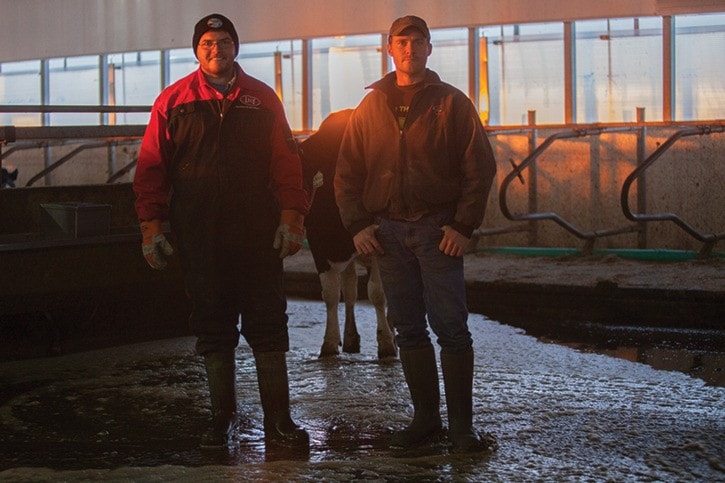The automated barn at the Haustein farm in Erskine looks no different from a modern barn from the outside.
Yet what is going on within, from milking to feeding to cattle bedding are some of the most advanced in the country.
At the family-run operation located a mile south of Erskine on Hwy. 835, one of the Haustein brothers, Conlee takes care of the dairy, while Calvert manages the crops, and his wife Amanda manages the beef from aspect of the business.
Their father Doug Haustein and mother Bernadette Haustein, along with Lory, Conlee's wife take care of the young animals and help whenever needed.
In addition, the children of Calvert and Amanda help around the farm, depending on what needs to be done.
"We milk crossbred cows (Fleckvieh x Holstein) because we feel they are more profitable," said Calvert Haustein. "Our cows are stronger healthier and give us less problems."
Although the barn has been in operation with its state-of-the-art facilities since March this year, the journey to where it is now has been a long and meticulous process.
"We started gathering ideas for the barn in 2010 after attending a progressive dairy conference regarding robotics and automation," said Calvert. "After deciding what type of milking system and housing system we wanted, we started with the barn layout design in 2012."
Earthwork began in the spring of 2013 and the construction of the building started late summer 2013.
"We were in need of a new milking facility as the previous barn was undersized, nearly 80 years old, having been a dairy barn for 41 years, and required lots of labour to milk cows," added Haustein. "We wanted a low-maintenance barn with low-operational costs."
Instead of having an anaerobic flush, the Hausteins decided to go with an aerobic flush barn, the only one of its kind in the country.
"Building an aerobic flush barn with a robotic milking system and a free-stall housing system seemed to be the most logical choice to achieve this," said Conlee Haustein. "The main inspiration for this was the fact that our parents, who have a big role on the farm aren't getting any younger and therefore something would need to be changed if we were to maintain the same level of income once they decided to retire."
The Hausteins took to the web to research what they wanted, backing it up with several visits to modern farms across the country, US and Europe.
They were determined to get it right.
"The decision to build an aerobic flush barn was realized after watching a YouTube video and touring some aerobic flush barns in Wisconsin," said Calvert. "We felt the benefits of doing an aerobic flush barn were too good to ignore."
According to the Hausteins, with an aerobic system, the barn floors are not slippery, cows' feet are kept clean, nitrogen is retained, odours are minimal, barn temperature can be regulated and lagoon manure water is used to irrigate crops when the plants make best use of the nutrients.
"As we were our own general contractor, we had the role of organizing all the necessary requirements to complete the job, so we would get quotes from different companies for different materials and products, compare the pros and cons for these different products before deciding which to choose," said Conlee. "We did a lot of touring of other dairy barns and assimilated ideas from all of them to help improve our plan, and make it the most modern."
With regard to the financing the project, Calvert said, "Funding was actually very simple and easy, as Farm Credit Canada (FCC) was our choice as a lender to cover the bulk of the costs, as they were the most eager to help and make us feel appreciated."
The Hausteins also availed some of the government grants, which were "quite easy to apply for and receive", even though they only equated to 0.5 per cent of the total cost of the project.
"Since we started using robots to milk the cows, we have noticed a big difference in labour needs," said Calvert. "Leading up to the last day milking in the old barn it would take two people and three hours to milk 80 cows twice a day, which would roughly translate to 0.15 hrs per cow per day."
According to Calvert, with the robotic milking it takes one person two-and-a-half hours to do chores for 100 cows twice a day, which is 0.05 hrs per cow per day.
"With a milking capacity of 120 cows, the required time spent doing chores shouldn't take too much from what our current chores are," added Conlee.
The Hausteins have another robot, called Juno, which helps move feed towards their cattle, gliding down the large barn and pushing hay towards the cows.
"My advice for someone looking to do the same thing would be to do your homework," said Conlee. "We spent a lot of time researching, trying to find the most cost-effective way of doing this."
